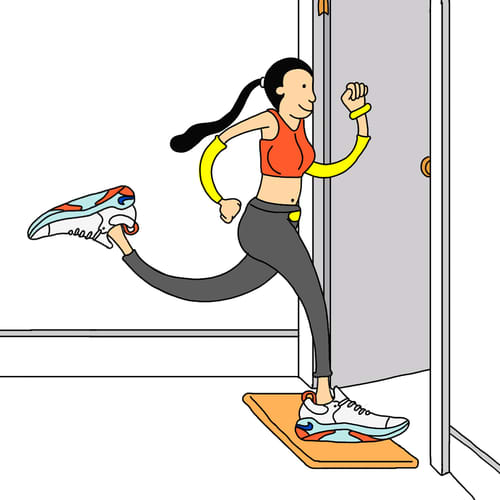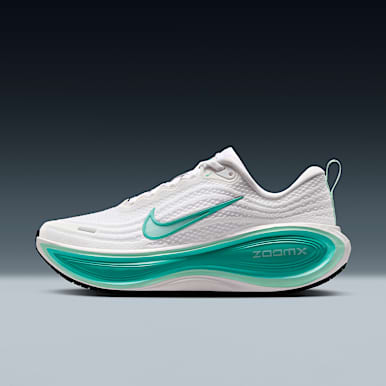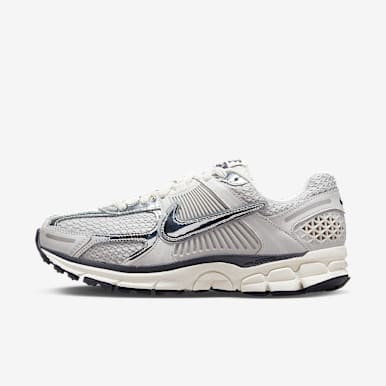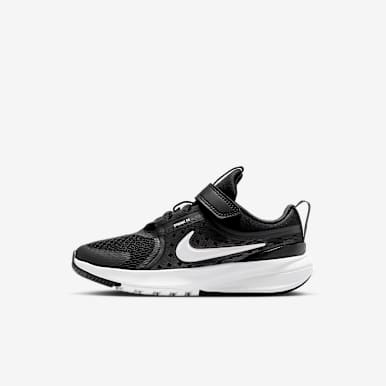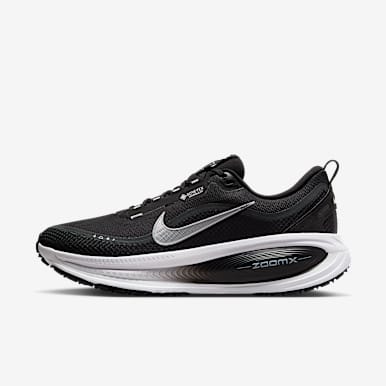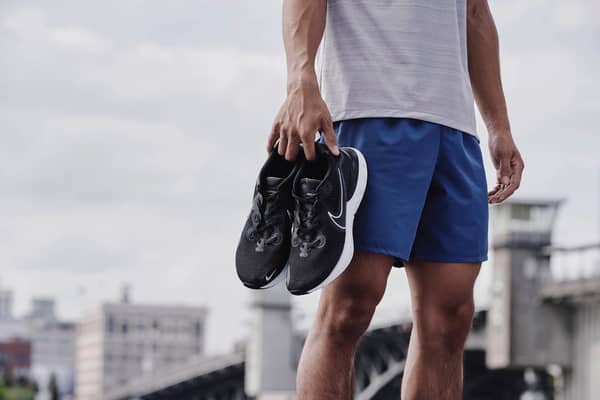How to start running (or get back into it after a long break)
Sport & activity
Whether you're just starting or returning to action, getting in running shape doesn't have to be a daunting process. Here are some expert tips to help you get (re)started.
How to start running
If it were as easy as slipping on your shoes and rolling out the front door, you wouldn't be reading this. Listen: we know that if you're someone who has never run or you've fallen out of a routine, lacing up for a first run can feel overwhelming.
But it doesn't need to be that way, says Nike Running Global Head Coach Chris Bennett. "The hardest part is not finishing the first run, it's starting the first run. Once you accept that, everything gets easier".
Coach Bennett is all about dropping the running wisdom, and we're here for it. Here's a list of things—practical and mental—to help you prep for your first run.
"The first run has nothing to do with pace, nothing to do with distance, nothing to do with duration. It's about starting it and ending it and wanting to do a next run".
Chris Bennett
Nike Running Global Head Coach
Prevent injury with stretching
Stretch while moving before your run …
Aim to do a few minutes of stretching with movement (aka dynamic stretching) before your run. Why this kind specifically? It mimics the full range of motion of a run, which helps you get looser, faster. If you're still feeling tight during your run, it's OK to stop and stretch some more. No guilt! That helps you to finish feeling great.
… and finish off with still stretches
Fact: doing dynamic and static stretches (ones you hold) post-run helps prevent injury and improve flexibility. "Those few minutes are so important", says Coach. "They'll make your next run better, I promise".
Stay on track with a training plan
Get an extra push with a Guided Run
The Nike Run Club's guided runs take you alongside Nike coaches, athletes and special guests who encourage you every step of the way.

How to return to running after a long break
Runners are known to go the extra mile. But even the most disciplined runner needs a break every now and then. Whether it's to heal an injury, recover from an illness or rediscover the motivation for running, taking a long break from running can be a healthy thing. Still, it's not always clear how you start running again once you're ready. Read on to find out.
What exactly is a long break?
The definition of a "long break" can vary from one runner to the next. But in general, any break that spans more than six weeks is considered long. Six weeks is how long it takes to see a significant drop in fitness, strength and running technique, according to Pete Colagiuri, a sports physiotherapist in Sydney, Australia.
The good news is you can regain fitness fairly quickly once you start running again. However, it may take a bit longer if you were a beginner when you took a break. Experienced runners tend to bounce back faster.
3 expert tips for returning to running after a long break
1.Start with strength training
"It's worth starting a running-focused strength programme at least two weeks before returning to running whenever possible", Colagiuri says. Strength training can help build up the muscles you need to run efficiently and avoid injuries. This can help both beginners and more experienced runners.
2.Rebuild slowly
You won't be able to hit your pre-break pace and mileage straight away—and that's fine. Just because you're motivated for a triumphant return to the race schedule doesn't mean your muscles, tendons and ligaments are. "The key is not to get discouraged with the process because if you try to build back too quickly, an injury could occur", says exercise physiologist Todd Buckingham, PhD. So, instead of jumping into a half-marathon or marathon training plan, you may want to start with a couch-to-5K.
3.Refresh your shoes
Kick off your return with a new pair of running shoes. "Often, people use their old pair and they don't realise how worn down and little cushioning they offer, which increases the impact forces on your muscles, tendons and joints", says Karena Wu, DPT, owner of ActiveCare Physical Therapy. That added impact can increase your risk of injury or re-injury. Plus, there's nothing like a fresh pair of kicks to motivate you to run.
Here are some recommendations for Nike sneakers when you're getting back in the game:
The Peg 41 is recognised for its breathability and lighter-weight energy return.
The InfinityRN 4 keeps you comfortable and supported, and the Invincible 3 provides maximum cushioning.
The 4-week reintroduction to running programme
If you're itching to hit the road (or treadmill), resist the urge to jump back in with both feet. Instead, rebuild your fitness gradually with this four-week run-walk programme from Jessica McManus, PT, owner of Full Circle Physical Therapy and Wellness Coaching.
Breaking up your runs with bouts of walking will help you build endurance while also increasing your tolerance for the repetitive impact forces of running. The result? A lower risk of injury from overloading your muscles, joints, tendons and ligaments.
Aim for three run-walk sessions per week. Take a rest or have a cross-training day in between each session.
Start every workout with a 10-minute walk or dynamic warm-up routine, or a combination of the two. McManus suggests moving through bodyweight exercises such as air squats, walking lunges, bum kicks and carioca movement for a dynamic warm-up.
● Week 1: walk 4 minutes, jog 2 minutes; 5 cycles
● Week 2: walk 3 minutes, jog 3 minutes; 5 cycles
● Week 3: walk 2 minutes, jog 4 minutes; 5 cycles
● Week 4: walk 1 minute, jog 5 minutes; 5 cycles
The goal is to build endurance for a full 30-minute jog by the end of the fourth week, McManus says. However, feel free to spend more time ramping up your walk-jog workouts if needed.
Pay attention to how you feel during these few weeks. Back off or pause running altogether if a prior injury crops up or you experience new pains.
You may be tempted to speed things up if you're running for weight loss. However, jumping ahead in the programme won't do your waistline any favours. In fact, it may do the opposite by increasing your risk of getting sidelined by injury.
Although running can be a great weight-loss tool, your time may be better spent nailing your nutrition, sleep and recovery. All the running in the world won't help you lose weight if these big rocks are out of place.
Strength training for runners
You need a solid strength training plan to get back into running—and continue running injury-free for the long-haul.
Strength training is especially important for runners returning from a leg injury. Even if you worked through your injury with a physiotherapist, the chances are you've lost a significant amount of strength.
Focus on rebuilding strength at least two days per week. Do your strength workouts on non-running days.
A few of McManus's favourite strength exercises for runners include:
1.Step-ups
This single-leg exercise targets the gluteus maximus (glute max) and gluteus medius (glute med). The glute max is a large, powerful muscle in your buttocks that plays a starring role in locomotion. Meanwhile, the glute med runs along the outside of each hip and helps stabilise your pelvis while you shift your weight from one leg to the other.
- Plant one foot on a sturdy bench or box. Check that your knee is stacked on top of your ankle.
- Lean your torso forwards slightly and push through your planted foot to straighten your leg. Try to keep your hips level as you step up. Allow your other foot to hover in the air.
- Lower your non-working foot to the floor slowly and with control.
- Do eight to 15 reps before switching legs. Do a total of three sets per leg.
- To really hammer your glute med, hold a weight in the hand opposite your stepping leg.
2.Lateral banded walks
This exercise using exercise bands is another great way to heat up the glute med.
- Loop a small resistance band around both legs just above the knees.
- Stand with your feet hip-width apart and bend your knees into a quarter-squat.
- Imagine you're balancing a full glass of water on your head. Without spilling that imaginary glass of water, step one foot to the side.
- Once that foot is planted, follow with the other foot so your feet are hip-width apart again.
- Take eight to 15 steps before switching directions. Do three sets in total.
3.Side planks
Side planks work the abdominal muscles. Primarily, the rectus abdominis in the centre of your torso and the obliques on each side of your trunk. However, side planks will also strengthen your glute med.
- Lie on your side with your legs extended and hips stacked.
- Bend both knees to draw your legs behind you. Prop up your upper body on your bottom elbow with the forearm and palm flat on the floor. Check that your elbow is in line with the bottom of your shoulder.
- Lift your hips off the floor and hold for 10 to 30 seconds.
- Keep your body in a straight line from your head to your knees while you hold. Don't allow your shoulders or trunk to tilt forwards or backwards.
- Once your time is up, lower your hips to the floor. Repeat on the opposite side. Do three sets in total.
Frequently asked questions about returning to running after a long break
How to start running after a long break
When returning to running after a long break, it's vital to take things slow. A run-walk programme that gradually increases the time spent running can help you rebuild fitness and strength without placing too much stress on muscles, joints, tendons and ligaments. Pair your run-walk sessions with a strength training programme to support key running muscles.
How to get back to running after an illness or injury
Whether you were sidelined by COVID-19, an ankle sprain or a knee injury, it's important to get cleared by your doctor or physiotherapist before trying to run again. Then, take a few weeks to focus on strengthening your muscles. Finally, return with a run-walk programme. Consider working one-on-one with a running coach or personal trainer. An expert can help you avoid injury or re-injury from running.
How to get back to running after pregnancy
First, get cleared by your doctor. Once you get the go-ahead, begin a programme that focuses on rebuilding core strength. When you're ready, ease back into running with a run-walk programme. Your best bet is to work with a physiotherapist who specialises in postnatal fitness, especially if you have any pelvic discomfort or pain, urinary incontinence or abdominal separation (diastasis recti).
